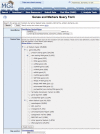The Mouse Genome Database (MGD): premier model organism resource for mammalian genomics and genetics
- PMID: 21051359
- PMCID: PMC3013640
- DOI: 10.1093/nar/gkq1008
The Mouse Genome Database (MGD): premier model organism resource for mammalian genomics and genetics
Abstract
The Mouse Genome Database (MGD) is the community model organism database for the laboratory mouse and the authoritative source for phenotype and functional annotations of mouse genes. MGD includes a complete catalog of mouse genes and genome features with integrated access to genetic, genomic and phenotypic information, all serving to further the use of the mouse as a model system for studying human biology and disease. MGD is a major component of the Mouse Genome Informatics (MGI, http://www.informatics.jax.org/) resource. MGD contains standardized descriptions of mouse phenotypes, associations between mouse models and human genetic diseases, extensive integration of DNA and protein sequence data, normalized representation of genome and genome variant information. Data are obtained and integrated via manual curation of the biomedical literature, direct contributions from individual investigators and downloads from major informatics resource centers. MGD collaborates with the bioinformatics community on the development and use of biomedical ontologies such as the Gene Ontology (GO) and the Mammalian Phenotype (MP) Ontology. Major improvements to the Mouse Genome Database include comprehensive update of genetic maps, implementation of new classification terms for genome features, development of a recombinase (cre) portal and inclusion of all alleles generated by the International Knockout Mouse Consortium (IKMC).
Figures



References
Publication types
MeSH terms
Substances
Grants and funding
LinkOut - more resources
Full Text Sources
Molecular Biology Databases

